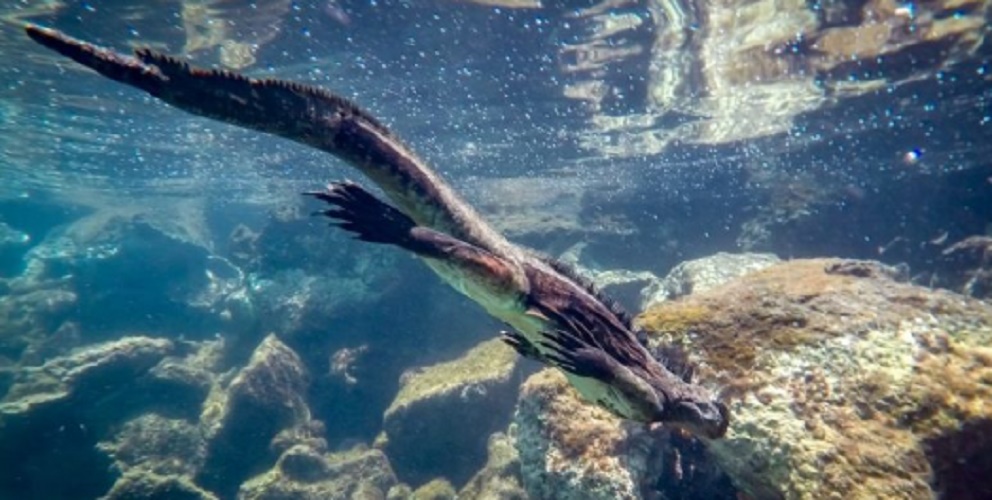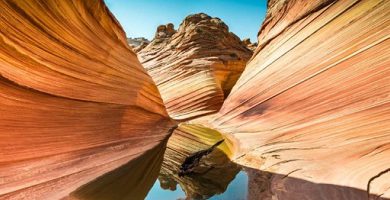Types And Characteristics Of Aquatic Animals With Examples
We explain what aquatic animals are, what types exist, the characteristics of aquatic animals, and examples. In addition, land and air animals.
What are aquatic animals?
Aquatic animals are those animals that live all the time or much of their life in the water, whether sweet or salty. They can breathe dissolved oxygen in water (through the gills or skin) or they can breathe it from the air (through the lungs).
The number of species that inhabit water is so wide that it was not yet fully discovered due to the inaccessible depths of the ocean. However, aquatic animals can be categorized in the same way as terrestrial animals (in vertebrates and invertebrates), taking into account the characteristics of the organisms and their adaptation to the aquatic environment.
Types of aquatic animals

Aquatic animals are divided into two large groups according to the internal structure of their organism: vertebrates or invertebrates .
Vertebrate aquatic animals
They are those that have a bone skeleton or a skeleton made up of cartilage, and are classified as:
Fishes. They are the ones who breathe through the gills, and they are divided into three types:
- Agnatos : They have no jaw, like river lamprey.
- Condrict : They have a cartilaginous skeleton, like the shark.
- Osteíctios : They have an internal bone skeleton, such as tuna.
Reptiles. They are those that have a pulmonary respiratory system, a double-circuit circulatory system, and flaky skin. Its reproduction can be oviparous or ovoviviparous. For example, the sea turtle, the sea snake, the marine iguana, and the crocodile.
Mammals. They are those who have a pulmonary respiratory system and are characterized by breastfeeding their young. They are divided into five groups:
- Cetaceans, such as the whale, beluga, and dolphin.
- Pinnipeds, such as the seal, the sea elephant, and the walrus.
- Sirenios, like the manatee and the dugongs.
- Pachyderms, like the rhinoceros and the hippo.
- Rodents, such as the otter and the capybara.
Birds. They are those that have plumage throughout their body, which allows them to stay dry to be able to fly or to maintain their body temperature. They feed on fish and crustaceans. For example, the penguin, the pelican, the seagull and the heron.
Invertebrate aquatic animals
They are those that do not have any type of bone skeleton or internal cartilaginous, and make up a group of six very different species from each other:
- The arthropods . They are aquatic crustaceans that inhabit the depths. They usually have a shell, a gill respiratory system, a complex nervous system and sexual reproduction. For example, the crayfish.
- Mollusks . They are aquatic animals that may have an exoskeleton called shell or shell (for example, mussel) or may not have an outer shell (for example, octopus). In both cases they have siphons (an anatomical structure that is part of the soft organs) through which filtered water enters and leaves, which makes locomotion, feeding, breathing and reproduction possible.
- The echinoderms They are those who live both in the depths of the sea and in shallow waters. They have an internal skeleton composed of calcareous plaques and ossicles (very small bones), and their organism has radial symmetry. For example, the starfish, the sea urchin and the ofiura.
- The worms. They are earthworms or marine worms that according to their anatomical form are classified as: ” annelids ” (segmented body in the form of rings), ” nematodes ” (cylindrical body) or ” platelmintos ” (flattened body). They have elongated and soft texture because they do not have a skeleton. Some live as parasites and feed on their victims. An example of annelid earthworm is the leech.
- The porifers. Also known as “sponges” are those that do not have differentiated tissues, nerves, muscles or organs, and many species have a radial symmetrical anatomy. The irregular shape of the body allows them the flow of water through their cavities and it is through the absorption of the water that they manage to nourish themselves.
- The celenteres. They are multicellular organisms that have only one opening (called “stomodeo”) of access to a single inner cavity that fulfills the function of both mouth and anus. Some species live clinging to the corals of the seabed and others float freely. They have a sexual and an asexual reproductive phase. For example, jellyfish, coral, hydra and polyp.
-
Characteristics of aquatic animals

Aquatic animals have different characteristics, according to:
The type of breathing Because the oxygen dissolved in the water has a lower concentration than that present in the air , aquatic animals have specialized organs to breathe and make gas exchange possible. They can breathe through:
- Gills , such as shark and manta ray.
- Skin , such as sea urchin and starfish.
- Lungs , like dolphin and whale.
The type of habitat. Aquatic animals cannot live in any type of water. Each species has characteristics that adapt to the environment that can be:
- Saltwater : the seas and oceans.
- Fresh water : rivers, lakes and lagoons.
The type of feeding. Feeding will depend on the type of habitat .
- In the salt sea water , for example, many marine animals eat the phytoplankton (microscopic size plant capable of transforming the light energy of the sun).
- In freshwater rivers or lakes , river salmon, for example, feeds on smaller fish, crustaceans and insects. Other species base their diet on seeds and fruits found on the banks.
The type of reproduction. Aquatic animals reproduce in two ways:
- Sexual : It can be oviparous, ovoviparous or viviparous. For example, the turtle, the white shark and the dolphin.
- Asexual : By external fertilization of ovules and sperms that are deposited in the water. For example, the starfish.
The type of body temperature. Some aquatic animals can acclimatize to the cold temperatures of their habitat thanks to their behavioral thermoregulation system that allows them to adapt to the water temperature or also thanks to the scales that cover the dermis.
-
Examples of aquatic animals

Some examples of aquatic animals are:
- Clam. It is a bivalve mollusk that is protected by a shell, lives buried in sand or mud and can withstand temperatures up to 5 ° C. It is one of the animals with the longest life: it can live up to 200 years.
- The vampire squid. It is a mollusk of deep, temperate and tropical waters. It shares similarities with the squid and octopus, although instead of expelling ink to confuse its attackers, a sticky substance emanates that takes about ten minutes to dissolve in the water.
- The dugongo It is a sirenium-type mammal that lives in coastal areas of the Indian and Pacific oceans, East Africa, Southeast Asia and Oceania. It feeds only on algae and can be more than fifteen minutes under water without breathing.
- The beluga It is a mammal of the cetacean type that usually lives in the Arctic. It is distinguished by its white skin, being very intelligent, sociable and curious. It feeds preferably on fish, although it also hunts shrimp, crabs and squid.
- The Penguin. It is a seabird that cannot fly, however, it is a skilled swimmer. It feeds on squid, fish and shrimp. It has an excellent view that allows you to see its preys at great distances.
- The sea snake It is a cold-blooded reptile, has scales, bifurcated tip tongue and changes its skin completely regularly (as with the earth snake). Inhabits tropical areas of the Pacific, Indonesia and Australia.
- The marine iguana. It is a scaly reptile that inhabits the Galapagos Islands (an archipelago of the Pacific Ocean) and, upon reaching adulthood, its dermis takes on a dark green color. Despite its sharp claws and teeth, it is herbivorous . It feeds on algae and aquatic plants, which can even tear out of the rocks.
-
Land animals

Terrestrial animals are those that live and move by land, which cannot fly or stay long in the water . They feed on plants and other animals, depending on the habitat in which they live (such as the area of the poles, forests, jungles or deserts).
They are classified into vertebrates and invertebrates. Some examples of vertebrate land animals are the giraffe, the lion , the dog, the camel and the horse. Among the invertebrate terrestrial animals, the spider, the grasshopper, the snail and the cockroach stand out.
-
Flying animals

Aerial animals are those with wings, which allow them to fly and move through the air . This feature makes it possible for them to live in different territories that are separated by large distances. They can look for their food on earth or in water.
They are also classified into vertebrates (such as the hummingbird, from the group of birds, or the bat, from the group of mammals) and invertebrates (such as the bee, from the group of insects).





